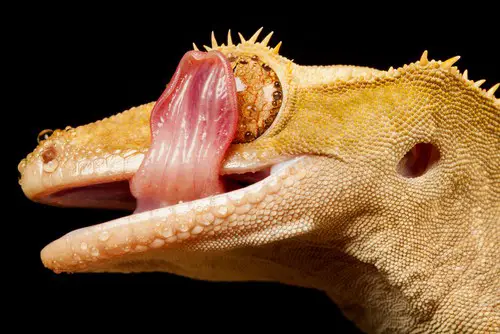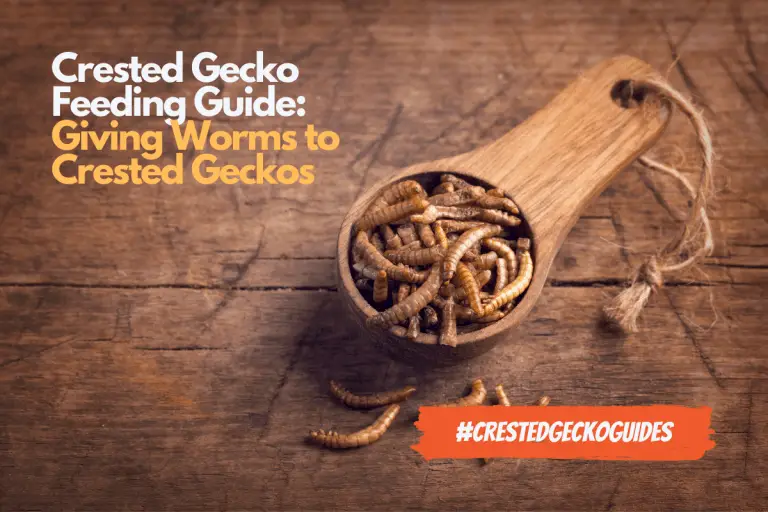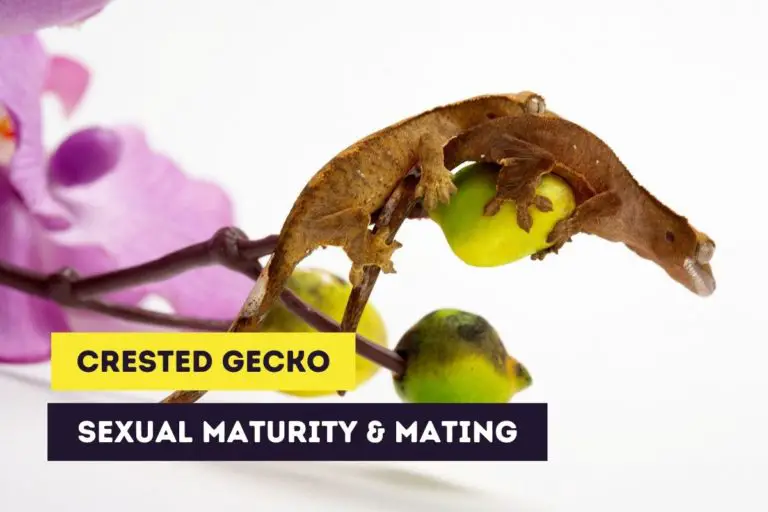Can Crested Geckos Live With Poison Dart Frogs?
Estimated reading time: 6 minutes
Crested geckos are friendly and quite docile creatures. If you’ve got an interest in reptiles and amphibians you might already own a poison dart frog and want to know if it can live with a crested gecko. Both require a humid vivarium and share similarities but there are also big differences between these two species.
Crested geckos can’t be kept with poison dart frogs. Crested geckos and poison dart frogs have very different needs and satisfying both is nearly impossible. Besides that, there’s a risk that the poison dart frog gets bitten or even killed by your crested gecko.
While both crested geckos and poison dart frogs need a high humidity vivarium the humidity requirements aren’t the same. Crested geckos are quite sensitive when it comes to humidity and a vivarium that has humidity above 80 percent can lead to health issues.
If you’re interested in stickers or other products of crested geckos, you can always visit our Etsy Shop, which is called Artful Animalia. We currently only send stickers in the United States. If you’re interested in certain crested gecko-related products, don’t hesitate to contact us.
In this article, you’ll learn a little bit about poison dart frogs and the differences between crested geckos and these dart frogs so you understand why both can’t be kept in the same vivarium.
This site contains affiliate links to products we recommend and use ourselves. We may receive a commission for purchases that you make through these links. If you’re interested in learning more about our affiliate links, please visit our (affiliate) disclaimer.
Introduction to Poison Dart Frogs
Poison dart frogs or poison-arrow frogs are a name for a group of frogs native to Central and South America. There are a lot of different frogs that fall in this group and they’re all diurnal creatures, so they’re most active during the day.
Toxicity
Poison dart frogs have bright-colored bodies and are known for their toxicity. While some have high toxicity, others have low or even no noticeable toxicity. The toxicity comes from the diet of the dart frog that consists of insects like ants and termites. In captivity, poison dart frogs are fed a diet that doesn’t cause the frog’s skin to be toxic. So, they can be kept safely as pets.
Size and weight
A majority of the poison dart frog species are small, with sizes from 0.59 inches (1.5 centimeters) to some larger species that can measure up to 2.4 inches (6 centimeters). They’re pretty tiny animals, even smaller than some insects that crested geckos feed on. A poison dart frog has an average weight of 1 oz. (28 grams).
Reproduction
Poison dart frogs lay eggs in moist places. The tadpoles go through a process (metamorphose) like other species of frogs.
Natural Habitat: Crested Gecko vs Dart Frog
The natural habitat of crested geckos
Crested geckos live in the rainforests of New Caledonia in an environment with a cold and dry season and a wet and hot season. Crested geckos are arboreal and will spend time on trees, plants, and the ground.
The natural habitat of poison dart frogs
Poison dart frogs live in tropical environments in Central and South America. Their habitat also has high humidity and can consist of tropical forests, rivers, lakes, and swamps. Although poison dart frogs usually live on the ground or close to it, they can also be found in trees (up to 33 ft from the ground).
Temperature: Crested Gecko vs Dart Frog
Temperature needs of crested geckos
Crested geckos live in a tropical environment but can’t tolerate temperatures too high or too low. A suitable temperature for a crested gecko during the day ranges from 72 to 78 °F (22 to 25 °C). At night, the temperature can be lower, running between 69 and 74 °F (20 to 23 °C).
Temperatures should never exceed 85 degrees Fahrenheit (29 degrees Celsius) unless your crested gecko can retreat to a much cooler area in the terrarium. If they’re not able to do this, your crestie will suffer from overheating.
Temperature needs of poison dart frogs
Poison dart frogs are also native to tropical environments and can tolerate the same temperatures as crested geckos do. During the day, the temperature should be between 72° F (22° C) and 80 °F (27 °C). At night, the temperature can be lowered and range from 60 °F (16 °C) to 65° F (18 °C).
Humidity: Crested Gecko vs Dart Frog
Humidity needs of crested geckos
Crested geckos are used to a humid environment and need the humidity to shed their skin and stay healthy properly. However, they can’t tolerate a humidity that’s too high and may suffer health issues when kept in a terrarium with an average humidity above 80 percent. On average, the humidity of a crested gecko terrarium should range from 50 to 70 percent.
Humidity needs of poison dart frogs
Poison dart frogs are used to a very humid environment and need the humidity to stay hydrated and healthy. Therefore, the terrarium’s humidity of poison dart frogs should range from 80 to 100 percent. Dart frogs can tolerate a humidity of 70 percent for a short period, but it’s best always to keep the humidity above 80 percent to prevent dehydration.
Diet: Crested Gecko vs Dart Frog
Diet of crested geckos
Crested geckos are omnivores eating both plants and animals. The diet consists mainly of insects, (rotten) fruit, and pollen from flowers in the wild.
In captivity, crested geckos are mainly fed a meal replacement powder that contains most of the necessary nutrients. You should add vitamins and supplements to create a well-balanced diet. Insects like crickets can be occasionally fed and fruit and worms should only be fed as a treat (when on a diet based on meal replacement powder or granulate food).
Diet of poison dart frogs
Poison dart frogs are carnivorous animals. They live on a diet that’s made up of meat like flies, ants, spiders, and termites. In captivity, they eat the same kind of food and there’s isn’t a meal replacement as is the case with crested geckos.
Can Crested Geckos Live With Dart Frogs?
From the differences between crested geckos and poison dart frogs, you can see that it isn’t wise to put them both in the same terrarium. You can’t get the right kind of humidity for both animals and trying to create a balance between the two is not possible without hurting one or both animals.
But the humidity isn’t the only problem you’ll encounter. Crested geckos aren’t aggressive, but they still prey on smaller animals like crickets and roaches. They might chase the dart frog and bite them. Crested gecko bites aren’t very deep but can cause injuries and even death to small animals like the poison dart frog.
So I wouldn’t recommend putting both animals in the same terrarium. Most likely, your dart frog will be stressed, bitten, or even killed by the crested gecko. It’s not worth putting it in such a risky situation if you’re an animal lover.
Should You Get a Crested Gecko or Dart Frog?
Since a crested gecko can’t live with a poison dart frog, you have two options:
- get both a crested gecko and dart frog and keep them in separate terraria
- get only a crested gecko or a dart frog
If you’re interested in getting a crested gecko, you should read more about why a crested gecko is a good pet and when it’s suitable for you.
Poison dart frogs can also make great pets as they’re easy to take care of, are relatively cheap to feed, and don’t need a large terrarium. If you’re interested in poison dart frogs, you should read this useful article.
Want to Learn More?
If you want to learn more about crested geckos as pets, please read the following articles.
If you’re interested in getting crested geckos as pets you should also definitely read our article about baby and juvenile crested gecko care or (adult) crested gecko care.







